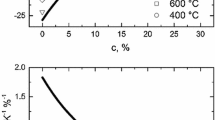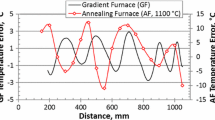Abstract
A technique is presented that enables the effects of temperature on the Seebeck coefficient to be assessed for individual wires. The technique, involving a high-resolution thermoelectric scanning rig and a nonuniform conditioning furnace of known temperature profile, was applied to 0.5-mm-diameter wires of Pt and Pt 10% Rh. Changes were observed in Seebeck coefficient when these wires were used in high-purity twin-bore insulation for up to 200 h at temperatures over the range 500 to 1700°C. Contamination from the insulation was found to be transmitted by a vaporization process, having an activation energy of 3 eV. This caused changes of up to 0.14 μV · °C−1 in Pt and 0.01 μV · °C−1 in Pt 10% Rh. Rhodium transfer to the pure Pt wire changed its Seebeck coefficient by up to 5 μV · °C−1. The consequences of both processes for thermocouple pyrometry are presented.
Similar content being viewed by others
References
G. E. Glawe and A. J. Szaniszlo, in Temperature, Its Measurement and Control in Science and Industry, Vol. 4, H. H. Plumb, ed. (Instrument Society of America, Pittsburgh, 1972), pp. 1645–1662.
A. S. Darling and G. L. Selman, in Temperature, Its Measurement and Control in Science and Industry, Vol. 4, H. H. Plumb, ed. (Instrument Society of America, Pittsburgh, 1972), pp. 1633–1644.
R. E. Bedford, High Temp. High Press. 4:241 (1972).
B. E. Walker, C. T. Ewing, and R. R. Miller, Rev. Sci. Instrum. 33:1029 (1962).
R. E. Bentley and T. P. Jones, High Temp. High Press. 12:33 (1980).
R. E. Bentley, Proceedings, Regional Workshop on Metrology for Developing Countries, Sydney, CSC(82) MS-21 (1982), Vol. 2, p. 228.
T. P. Jones and T. M. Egan, Inst. Phys. Conf. Ser. (26), B. F. Billing and T. S. Quinn, eds. (Institute of Physics, London and Bristol, 1975), p. 211.
T. P. Jones and K. G. Hall, Metrologia 15:161 (1979).
R. E. Bentley and T. M. Morgan, Metrologia 20:61 (1984).
E. H. McLaren and Murdock, The Properties of Pt/PtRh Thermocouples for Thermometry in the Range 0–1100°C, Vol. 2 (National Research Council of Canada Publication APH- 2213/NRCC 17408, 1979), pp. 31–42, 91–124.
A. Goldsmith, T. E. Waterman, and H. J. Hirschhorn, Handbook of Thermophysical Properties of Solid Materials, Vol.1 (Macmillan, New York, 1961), pp. 371–372.
R. L. Powell, W. J. Hall, C. H. Hyink, Jr., L. L. Sparks, G. W. Burns, M. G. Scroger, and H. H. Plumb, Thermocouple Reference Tables Based on the IPTS-68 (National Bureau of Standards (US) Monogr. 125, 1974), pp. 19–88.
D. W. Rhys and P. Taimsalu, Engelhard Ind. Tech. Bull. 10:41 (1969).
G. L. Selman, in Temperature, its Measurement and Control in Science and Industry, Vol. 4, H. H. Plumb, ed. (Instrument Society of America, Pittsburgh, 1972), pp. 1833–1840.
Author information
Authors and Affiliations
Rights and permissions
About this article
Cite this article
Bentley, R.E. Changes in seebeck coefficient of Pt and Pt 10% Rh after use to 1700°C in High-purity polycrystalline alumina. Int J Thermophys 6, 83–99 (1985). https://doi.org/10.1007/BF00505793
Received:
Issue Date:
DOI: https://doi.org/10.1007/BF00505793




